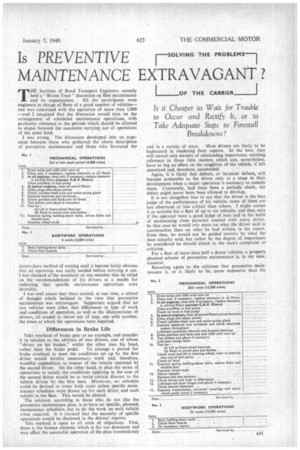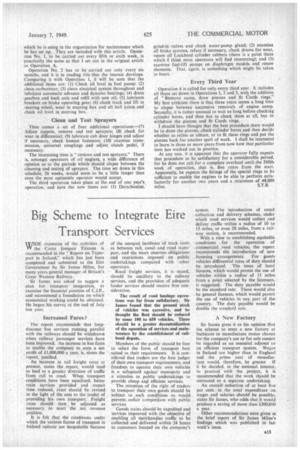Is PREVENTIVE MAINTENANCE
Page 39

Page 40

Page 41

If you've noticed an error in this article please click here to report it so we can fix it.
THE Institute of Road Transport Engineers recently held a " Brains Trust" discussion on fleet maintenance
and its organization. All the participants were engineers in charge of fleets of a good number of vehiclesone was concerned with the operation of more than 1,000 -and I imagined that the discussion would turn on the arrangement of scheduled maintenance operations, with particular reference to the periods which should be allowed to elapse between the successive carrying out of operations of the same kind.
I was wrong. The discussion developed into an argument between those who preferred the above description of preventive maintenance and those who favoured the
laissez-faire method of waiting until it became fairly obvious that an operation was really needed before carrying it out.
I was shocked at the statement of one member that he relied on the recommendations of his drivers as a means for indicating that specific maintenance operations were desirable.
I was well aware that there existed, at one time, a school of thought which inclined to the view that preventive maintenance was extravagant. Supporters argued that no Iwo vehicles were alike; that differences in type of work and conditions of operation, as well as the idiosyncrasies of drivers, all tended to throw out of step, one with another, the times at which the operations were required.
Differences in Brake Life
Take overhaul of brake gear as an example, and consider it in relation to the abilities of two drivers, one of whom "drives on his brakes," whilst the other uses his head, rather than the brake pedal. To arrange a period for brake overhaul to meet the conditions set up by the first driver would involve unnecessary work and, therefore, wasteful expenditure in respect of the vehicle operated by the second driver. On the other hand, to plan the series of operations to satisfy the conditions applying in the case of the second driver would be to invite certain disaster to the vehicle driven by the first man. Moreover, no schedule could be devised to cover both cases unless specific maintenance schedules were drawn up for each driver and each vehicle in the fleet. This would be absurd.
The solution, according to those who do not like the preventive maintenance plan, is to have no specific, planned, maintenance schedules, but to do the work on each vehicle w hen required. It is claimed that the necessity of specific operations would be disclosed in the drivers' reports.
This method is open to all sorts of objections. First, there is the human element, which is far too dominant and may affect the successful operation of the plan tremendously and in a variety of ways. Most drivers are likely to be haphazard in rendering their reports. At the best, they will record only matters of outstanding importance, omitting reference to those little matters which can, nevertheless. have so big an effect on the condition of the vehicle, if left unnoticed and, therefore, unattended.
Again, it is likely that defects, or incipient defects, will become noticeable to the driver only at a stage in their development when a major operation is necessary to remedy them. Conversely, had there been a periodic check, the defect might never have been allowed to develop.
It is not altogether true to say that the driver is the best judge of the performance of his vehicle; some of them are less observant or less critical than others. I might accept it as suitable for a fleet of up to six vehicles, and then only if the operator were a good judge of men and in the habit of maintaining close personal contact with every driver. In that case he would rely more on what the driver said in conversation than on what he had written in his report. Even then, he would not be guided entirely by what the man actually said, but rather by the degree of importance he considered he should attach to the man's complaint or criticism.
For a fleet of more than half a dozen vehicles, a properly planned scheme of preventive maintenance is, in my view. essential.
Reverting again to the criticism that preventive maintenance is, or is likely to be, more expensive than the
"wait-until-it-happens" method, how does anyone ever get to know 'whether it is more expensive or not? All that is known, to any degree of accuracy, is the actual expenditure in each case. The cost to the operator in loss of use of vehicles which have to be put erff the road because defects have developed, is an expense factor which can never be known when viewed in the light that the defect would newer have occurred if a system of preventive maintenancehad been in operation.
Moreover, extravagance in the application of preventive maintenance-which occults, presumably, because the operations arc too closely spaced-need be small and can be quickly corrected. After a time the preventive maintenance scheme settles down to a form which is, directly, as cheap as any other and, indirectly, for the reasons already given, Much more economical in the long run.
Maintenance Scheme for i Haulier
Some readers may recall the article in which described a plan for maintenance devised to meet the needs of a haulier friend of mine. I took. quite unashamedly, Capt. J. B. Walton's -scheme as a basis, modifying it as seemed advisable to meet the conditions of operation of this haulier's fleet of 18 vehicles. Most of these modifications were made to suit the views of this operator and his opinions had been formed as the result of practical experience.
• He did not agree. for example, that tappets needed adjustment so often as required in Capt. Walton's schedules. As regards oil changes. he rather surprised me. His practice was to change the oil in his petrol engines every 3,000 miles and in oil engines every 4,000 miles. I should have expected the reverse. Further discussion of the point brought to light the fact that he was using H.D. oils in the oil engines. He was doing so on the recommendation and under the guidance of one of the leading oil merchants and it is, therefore, to be presumed that this procedure, having the approval and blessing of the experts, is correct.
Another point which arose in the course of the discussion of this schedule of maintenance operations, was the basis on which periods between successive maintenance operations should be planned. There was a peculiar condition here which seemed likely to make this point a little difficult to settle: The vehicles were engaged on two classes of work. In one the annual mileage approximated to 24,000, and the a14 work was of a kind which involved many stops and starts on each journey. These conditions applied to about half the fleet of 18 vehicles. The other machines covered annual mileages of 36,000 to 40,000 each and the journeys were mainly point-to-point.
Experience had shown that the vehicles on the lower annual mileages were in more frequent need of maintenance if the period were regarded on a mileage basis. After a little discussion it was decided that a time basis could be arranged to apply to all the fleet and would, in fact, overcome the problem that those -machines doing the shorter runs would normally have their maintenanCe operations carried out over shorter periods, reckoning the periods in mileages. In consequence, it was agreed that a basic period of six weeks should be taken and readers will remember that in "the previous article I drew imp a schedule of operations covering a period of three years.
have now received from this operator the printed forms
which he is using in the organization for maintenance which he has set up. They are included with this article. Operation No. 1, to be carried out every fifth or sixth week, is practically the same as that I set out in the original article as Operation A.
Operation No. 2 has to be carried out only every six months, and it is in reading this that the interest develops. Comparing it with Operation 1, it will be seen that the additional items are: (I) Check oil level in fuel pump; (2) clean carburetter; (3) clean electrical system throughout and lubricate automatic advance and dynamo bearings; (4) drain gearbox and back axle and refill with new oil; (5) lubricate brackets on brake operating gear; (6) check track and lift in steering wheel, wear in steering box and all ball joints and check oil level in steering box.
Clean and Test Sprayers
Then comes a set of four additional .operations:—(7) Adjust tappets, remove and test sprayers; (8) check for wear in differential; (9) lubricate cab door hinges and adjust if necessary, check bonnet fasteners; (10) examine transmission, universal couplings and adjust clutch pedal, if necessary.
The interesting item is "remove and test sprayers." There is, amongst operators of oil engines, a wide difference of opinion as to the periods which should elapse between the cleaning and testing of sprayers. The time set down in this schedule, 26 weeks, would seem to be a little longer than even the most optimistic operator would accept. The third operation takes place at the end of one year's operation, and here the new items are: (1) Decarbonize,
grind-in valves and check water-pump gland; (2) examine all brake systems, reface if necessary, check drums for wear, renew all Lockheed cylinder rubbers (there is a point there which I think most operators will find interesting); and (3) examine fuel-lift pumps on diaphragm models and renew elements. That, again, is something which might be taken to heart.
Every Third Year
Operation 4 is called for only every third year. It includes all those set down in Operations I, 2 and 3, with the addition of " Remove sump, draw pistons and fit Cords rings." My first criticism there is that three years seems a long time to elapse between successive removals of engine sump. Secondly, it is rather unusual to wait so long before checking cylinder bores, and then tiot to check them at all, but to withdraw the pistons and fit Cords rings. T should have thougnt that the best procedure there would be to draw the pistons, check cylinder bores and then decide whether to reline or rebore, or to fit these rings and put the pistons back for another spell of work. I shall be interested to learn in three or more years from now how that particular item has worked out in practice. At any rate, it is apparent that the operator fully expects that procedure to be satisfactory for a considerable period, for he does not call for a complete overhaul until .the 260th week of operation, that is, five years from the start. Apparently, he expects the fittings of the special rings to he sufficient to enable the engines to be able to perform satisfactorily for another two years and a minimum of 48,000 miles. S.T. R




















































































